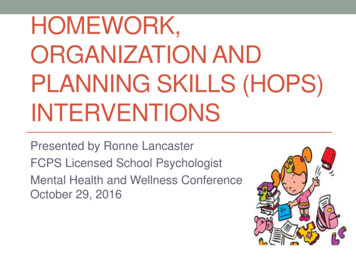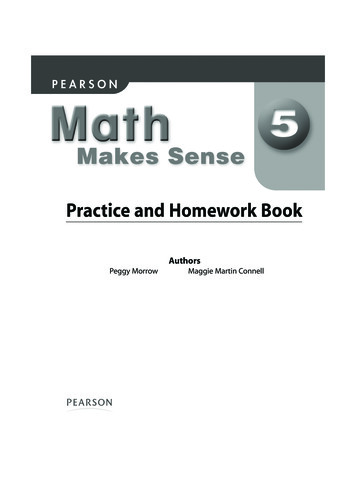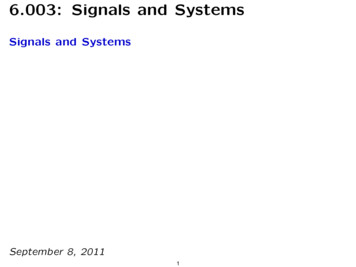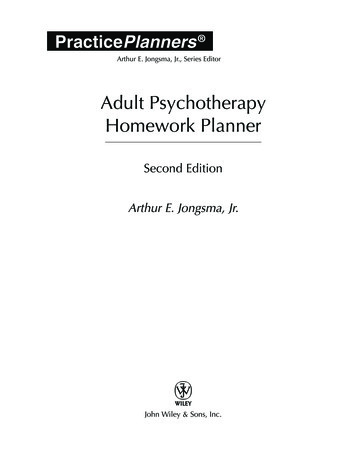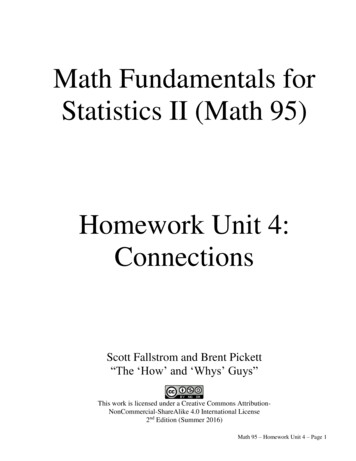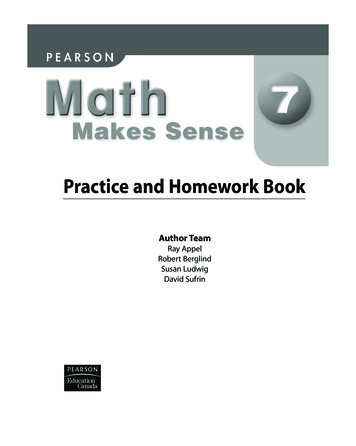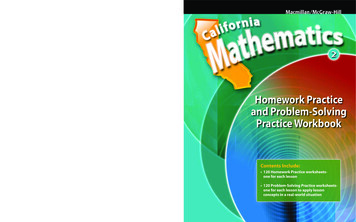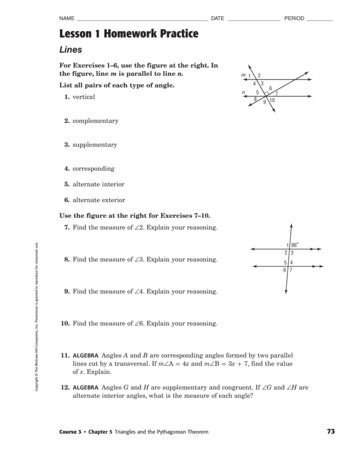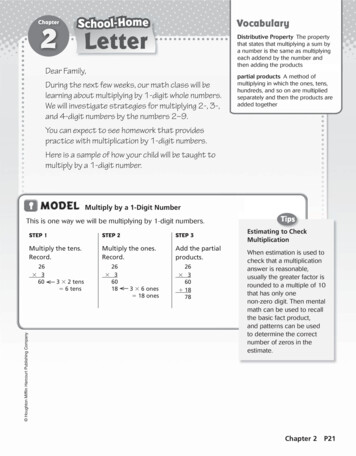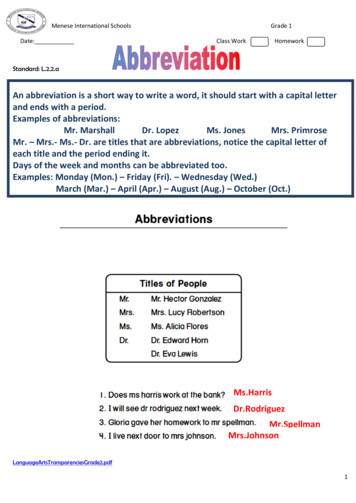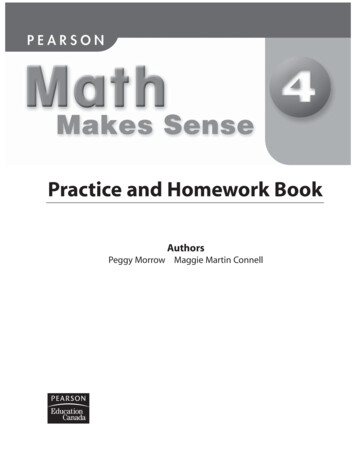
Transcription
Practice and Homework BookAuthorsPeggy Morrow Maggie Martin Connell
PublisherClaire BurnettElementary Math Team LeaderDiane WymanPublishing TeamLesley HaynesEnid HaleyIoana GageaLynne GulliverStephanie CoxJudy WilsonProduct ManagerKathleen CrosbieDesignWord & Image Design Studio Inc.TypesettingComputer Composition of Canada Inc.Copyright 2008 Pearson Education Canada, a division of Pearson Canada Inc.All Rights Reserved. This publication is protected bycopyright, and permission should be obtained fromthe publisher prior to any prohibited reproduction,storage in a retrieval system, or transmission in anyform or by any means, electronic, mechanical,photocopying, recording, or likewise. Forinformation regarding permission, write to thePermissions Department.ISBN-13: 978-0-321-43803-4ISBN-10:0-321-43803-5Printed and bound in Canada.3 4 5 -- WC -- 11 10 09 08
ContentsUNIT1UNIT2UNIT3Patterns and Equations . . . . . . . . . . . . . . . . . . . . . . . . . . . .Lesson 1Lesson 2Lesson 3Lesson 4Lesson 5Patterns in ChartsExtending Number PatternsRepresenting PatternsEquations Involving Addition and SubtractionEquations Involving Multiplication and Division246810Whole Numbers . . . . . . . . . . . . . . . . . . . . . . . . . . . . . . . . . .Lesson 1Lesson 2Lesson 3Lesson 4Lesson 5Lesson 6Lesson 7Lesson 8Lesson 9Lesson 10Lesson 12Lesson 13Whole Numbers to 10 000Comparing and Ordering NumbersSorting NumbersEstimating SumsUsing Mental Math to AddAdding 3-Digit NumbersAdding 4-Digit NumbersEstimating DifferencesUsing Mental Math to SubtractSubtracting 3-Digit NumbersSubtracting 4-Digit NumbersSolving Addition and Subtraction Problems121416182022242628303234Multiplication and Division Facts . . . . . . . . . . . . . . . . . . .Lesson 1Lesson 2Lesson 3Lesson 4Lesson 5Lesson 7Lesson 8Lesson 9Lesson 10Using Doubles to MultiplyMultiplying by 1, by 0, and by 10Using Skip Counting to MultiplyOther Strategies for MultiplyingUsing Patterns in a Multiplication ChartUsing Arrays to DivideRelating Multiplication to DivisionDividing by Numbers from 1 to 9Pose and Solve Problems363840424446485052iii
UNIT4UNIT5Measurement. . . . . . . . . . . . . . . . . . . . . . . . . . . . . . . . . . . . .Lesson 1Lesson 2Lesson 3Lesson 4Lesson 5Lesson 6Lesson 7Lesson 8Lesson 9Lesson 10Lesson 11Lesson 13Lesson 1Lesson 2Lesson 3Lesson 4Lesson 5Lesson 9Lesson 10Lesson 11Lesson 12Lesson 13Lesson 146iv545658606264666870727476Fractions and Decimals . . . . . . . . . . . . . . . . . . . . . . . . . . . .Lesson 7Lesson 8UNITCalendar TimeExploring TimeTelling TimeElapsed TimeTelling Time to the MinuteThe 24-Hour ClockCovering ShapesExploring AreaMeasuring Area in Square CentimetresEstimating and Measuring AreaFinding Area in Square MetresExploring Rectangles with Equal AreasFractions of a WholeFraction BenchmarksExploring Fractions of a SetFinding a Fraction of a SetRelating Fractional Parts ofDifferent Wholes and SetsComparing and Ordering Unit FractionsComparing and Ordering Fractionswith the Same Numerator or DenominatorExploring TenthsExploring HundredthsEquivalent DecimalsAdding Decimals to TenthsSubtracting Decimals to TenthsAdding and Subtracting Decimalsto Hundredths7880828486889092949698100102Geometry . . . . . . . . . . . . . . . . . . . . . . . . . . . . . . . . . . . . . . . .Lesson 1Lesson 2Lesson 3Lesson 5Lesson 6Lesson 7Objects in Our WorldConstructing PrismsExploring NetsSymmetrical ShapesLine SymmetrySorting by Lines of Symmetry104106108110112114
UNIT7UNIT8Data Analysis . . . . . . . . . . . . . . . . . . . . . . . . . . . . . . . . . . . . .Lesson 1Lesson 2Lesson 3Lesson 4Reading Pictographs and Bar GraphsDrawing PictographsDrawing Bar GraphsComparing Pictographs and Bar Graphs116118120122Multiplying and Dividing Larger Numbers . . . . . . . . . . .Lesson 1Lesson 2Lesson 3Lesson 5Lesson 6Lesson 7Lesson 8Lesson 9Lesson 10Lesson 11Exploring Multiplication PatternsEstimating ProductsUsing Models to MultiplyOther Strategies for MultiplicationUsing Patterns to MultiplyMultiplying a 3-Digit Number by a 1-DigitNumberEstimating QuotientsDivision with RemaindersUsing Base Ten Blocks to DivideAnother Strategy for DivisionMath at Home124126128130132134136138140142145v
To the TeacherThis Practice and Homework Book provides reinforcement of the concepts and skillsexplored in the Pearson Math Makes Sense 4 program.There are two sections in the book. The first section follows the sequence of Math MakesSense 4 Student Book. It is intended for use throughout the year as you teach the program.A two-page spread supports the content of each core lesson in the Student Book.In each Lesson:Quick Review summarizesthe math concepts andterminology of theStudent Book lesson.Try These presentsquestions the studentcan use to check understanding of the mathconcepts and skills ineach lesson.The right page is the“homework” page, to becompleted by the student with the assistanceof a family member.Stretch Your Thinkingpresents an extensionquestion.Math at HomeThe second section of the book, on pages 145 to 156, consists of 3 pull-out Math at Homemagazines. These fun pages contain intriguing activities, puzzles, rhymes, and games toencourage home involvement. The perforated design lets you remove, fold, and send homethis eight-page magazine after the student has completed Units 3, 6, and 8.vi
To the FamilyThis book will help your child practise the math concepts and skills thathave been explored in the classroom. As you assist your child to completeeach page, you have an opportunity to become involved in your child’smathematical learning.The left page of each lesson contains a summary of the main concepts andterminology of the lesson. Use this page with your child to review thework done in class. The right page contains practice.Here are some ways you can help: With your child, read over the Quick Review. Encourage your child totalk about the content and explain it to you in his or her own words. Read the instructions with (or for) your child to ensure your childunderstands what to do. Encourage your child to explain his or her thinking. Some of the pages require specific materials. You may wish to gatheritems such as a centimetre ruler, index cards, a measuring tape,scissors, number cubes labelled 1 to 6, and paper clips.Many of the Practice sections contain games that will also improve yourchild’s math skills. You may have other ideas for activities your child canshare with the rest of the class.The Math at Home pull-out pages 145 to 156 provide more fun activities.vii
TUTD E N B OO1KSUNIT 1Patternsin ChartsXxxLESSO NmehoolQuick ReviewAt ScAt HoLook at this hundred chart. There is a pattern in thecircled numbers.The pattern rule is:Start at 3. Count on by 3s. There is a pattern in thepositions of the squareswith circles.The pattern rule is:The squares with circles liealong every third diagonal.The diagonals go 1 down, 1 left.Try These1. Look at the squares with circlednumbers on this hundred chart.a) Describe the position pattern.b) Write the number pattern.c) Write a pattern rule for thenumber pattern.d) Circle numbers to complete the pattern on the hundred chart.2
Practice101102103104105106107108109110Circle these numbers.b) Start at 102. Count on by 5s.Put an X on each number.c) Write the numbers that haveboth an X and are 1192193194195196197198199200 85510152025303566121824303642771421283542491. a) Start at 102. Count on by 2s.d) Write the pattern rule for thenumber pattern in part c.2. Look at the squares with circlednumbers in this multiplication chart.a) Write a pattern rule for theposition pattern.b) Write a pattern rule for the numberpattern.Stretch Your ThinkingFollow this position rule. Putan X in the squares on the chart.The squares with an X lie alongevery third diagonal, starting atthe first diagonal. The diagonalsgo 1 down and 1 72829303132333435363738394041424344454647483
TUTD E N B OO2KSUNIT 1Extending NumberPatternsLESSO NQuick ReviewmeAt ScAt Ho Here is a pattern of squares drawnon dot paper.lhooSquare Number of Dotson Perimeter1428312416520 One pattern rule for the numberof dots on the perimeter is:Start at 4. Add 4 each time.Another pattern rule for thenumber of dots is:Multiply the square number by 4. The number of dots on any perimeter is a number we get when westart at 0 and skip count by 4.For the 10th square, skip count by 4 ten times:4, 8, 12, 16, 20, 24, 28, 32, 36, 40The 10th square will have 40 dots on its perimeter.Try These1. a) Complete the table for this pattern.TriangleNumber of Dotson Perimeter1234 b) Write the pattern rule.c) Which triangle will have 21 dots? 30 dots?d) Will any triangle have 22 dots?Why or why not?4
Practice1. a) Complete the table for this pattern ofFigurePerimeter(units)16regular hexagons.Figure 1Figure 2Figure 3Figure 4The side length of each hexagon is 1 unit.b) Write the pattern rule for the perimeters.234 c) Which figure will have a perimeter of 22 units? 34 units?d) Predict the perimeter of the 10th figure.e) Will any figure have a perimeter of 40 units? Explain.2. a) Complete the table forFigurethis pattern.Perimeter(units)Area(square units)1Figure 12Figure 2Figure 33Figure 44 b) Write the pattern rule for the areas.Stretch Your Thinking1. a) Which figure in question 2 will have a perimeter of 60 units?What will its area be?b) Which figure in question 2 will have an area of 81 square units?What is its perimeter?5
TUTD E N B OO3KSUNIT 1Representing PatternsLESSO NQuick ReviewHere is a pattern.From the table, the Squares in a Figureincrease by 2.Here are 2 different ways to build this pattern:meAt ScAt HoFigure1234Squares inFigure2468lhoo 2 2 2 Pattern 1Pattern 2The pattern rule for the number of squares in a figure is:Start at 2. Add 2 each time.Try These1. a) Use counters to build this pattern.FigureRecord the pattern below.1234Counters ina Figure1357 b) What is a pattern rule?6
Practice1. a) Use toothpicks to build this pattern.FigureDraw the pattern below.1234Toothpicks ina Figure2468 b) Write a pattern rule.c) How many toothpicks would be in the eighth figure?2. a) Use counters to build this pattern.Record the pattern below.Figure1234Counters ina Figure25811 b) Build the pattern in a different way.Record the pattern below.c) Write a pattern rule:Stretch Your ThinkingChoose a pattern rule.Complete the data in the table.Draw the pattern below.FigureSquares in aFigure1234 7
TUTD E N B OO4KSUNIT 1Equations InvolvingAddition and SubtractionLESSO NQuick Review 6 Use counters.Take away all but6 counters.Count the countersyou took away.So, 15 – 9 6 Draw a picture.15 – 9 6 Use guess and test.Guess: 7Test: 15 – 7 8 This is too low.Guess: 9Test: 15 – 9 6 This is correct.Try These1. Use counters to solve each equation.Rewrite each equation.Replace the symbol with the correct value.a) 8 40b) 25 –c) 17 248 15d)– 25 20lhooHere are 3 ways to solve this subtraction equation: 15 –Put out 15 counters.meAt ScAt Ho
Practice1. Write an equation for each set of counters.a)b) 2. Use counters to solve each equation.a) –8 8b) 7 24c) 15 – 13 3. Draw a picture to solve each equation.a) 19 – 14b) 5 16 4. Use guess and test to solve each equation.a) 53 68 b)37 – 14 5. Write a story problem you could solve using the equation: 20 38 –Solve the equation.Stretch Your ThinkingSolve: 126 847 1000 9
TE N T B OOUD5KSUNIT 1LESSO NEquations InvolvingMultiplication andDivisionQuick ReviewDivide the counters into 4 equal groups. Draw a picture.4 3 12 Use mental math.Think of a related division fact.What do we divide 12 by to get 4?12 3 4So, 4 3 12Try These1. Use counters to solve each equation.a) 5 c) 20 b) 24 3 6 d)e) 2 3 10 12 6 8 32 f) 7 6 lhooHere are 3 ways to solve this multiplication equation: 4 Use counters.Put out 12 counters.meAt ScAt Ho
Practice1. Write a multiplication and division equation for each picture.a)b)2. Draw a picture to solve each equation.a) 9 18 b) 14 2c) 6 12 3. Use mental math to solve each equation.a) 9 81 b) 21 3 c) 3 27 4. Write a story problem that could be solved by using this equation: 28 7.Solve the problem.Stretch Your ThinkingUse these numbers and some of these symbols: 3, 4,Write as many different equations as you can., , , .11
TUTD E N B OO1KSUNIT 2XxxWhole Numbers to 10 000LESSO NQuick ReviewmeAt ScAt HolhooYou can show the number 1453 in different ways. Use Base Ten Blocks.1 thousand4 hundreds5 tens3 ones Use a place-value chart.Thousands1Hundreds4Tens5Ones3 Use expanded form. 1453 1000 400 50 3 Use words. 1453 is one thousand four hundred fifty-three.The number 1453 is written in standard form.Every digit has a place value, depending on its position.Try These1.Write each number in standard form.a) two thousand six hundred thirteenb) 8000 600 40 12. Write each number in expanded form.a) 7125b) 23073. Write each number in words.a) 1620b) 340812
Practice1.Complete the chart.Standard FormExpanded Form2. Write each number in words.a) 3602b) 50453. Use each of these digits once to make each 4-digit number: 4, 2, 7, 5a) the greatest possible numberb) the least possible numberc) the greatest number with 5 tensd) the least number with 5 onesStretch Your ThinkingUse 5, 3, 1, and 7 once in each number you make.Make as many 4-digit numbers as you can.13
TUComparing and OrderingNumbersTD E N B OO2KSUNIT 2LESSO NQuick ReviewmeAt ScAt HolhooHere are some ways to order the numbers 3261, 3621, and 2163from least to greatest. Use a place-value chart.Thousands332Hundreds2612163 has thefewestthousands,so it is theleast number.Tens626Ones113Both 3261 and 3621have 3 thousands.Compare theirhundreds.200 600So, 3261 3621 means less than. means greater than. Use a number line.21632000326125003000362135004000From least to greatest: 2163, 3261, 3621Try These1.Compare each pair of numbers. Write , , or .a) 627485b) 26414824c) 268326832. Write the numbers in order from least to greatest.758, 709, 7413. Write the numbers in order from greatest to least.7148, 6271, 728514
Practice1.Play this game with a partner.The object of the game is to make the greater number.You will need a paper bag containing 10 cards with the digits 0 to 9. Draw a card from the bag.Record the digit in any space in the first row of your game board.Return the card to the bag. Take turns until each player fills all four spaces in a row. Compare your numbers.Write or in the box between the numbers.The player with the greater number wins a point. Play two more rounds.The player with the most points at the end of the game wins.Player 1Player 22. a) Put your numbers from the game in order from least to greatest.b) Put your partner’s numbers in order from greatest to least.Stretch Your ThinkingMake up three 4-digit numbers.Order the numbers from greatest to least.15
TUTD E N B OO3Sorting NumbersKSUNIT 2LESSO NQuick ReviewmeAt ScAt HolhooHere are four ways to sort these numbers.86225895300751000721Venn DiagramVenn Diagram1000861000225895 3007586300721Have 2 digitsLess than 500Venn DiagramOddOddCarroll DiagramGreater than 200225895721895721Have 3 digits30022575Digits add toless than 108675EvenOdd3001000225Digits add to10 or more8675 721 895 1000Try These1.Use each Venn diagram to sort these numbers.94 27 85 13 44 76a)b)c)Digits add to 13Odd16EvenLess than 50Multiples of 2Even
Practice1.Sort these numbers in each Venn diagram.421 718 246 967 358 709 626a)Less than 900b)EvenDigits add to 16Odd2. Use a coloured pencil to write one more number in each part of the Venndiagrams in question 1.3. a) Sort these numbers in theCarroll diagram.56 101 77 84 50 12691 105EvenOddMultiples of 7b) Use a coloured pencil to writeanother number in each boxin the Carroll diagram.Not Multiples of 7 4. Elmo travels to Sweden every three years.Sven visits Sweden every four years.Both men went to Sweden in 2006.Use a Venn diagram to find the yearin which both men will visit Sweden again.Stretch Your ThinkingChoose two attributes. Label the circles.Sort these numbers in the Venn diagram.1514 2658 947 352 685 410917
TUTD E N B OO4KSUNIT 2Estimating SumsLESSO NQuick ReviewmeAt ScAt HolhooWhen a question asks “about how many,” you can estimate.Here are some ways to estimate the sum of 294 351. Write each number to the closest 100.294 is closest to 300.351 is closest to 400.300 400 700So, 294 351 is about 700. Use front-end estimation.Add the first digits of thenumbers.200 300 500So, 294 351 is about 500.For a closer estimate:Think about 94 and 51.This is about 100 50 150.So, 294 351 is about 500 150 650.Try These1.Estimate each sum.a) 198 389b) 119 408c) 640 192Estimate:Estimate:Estimate:d) 79 272e) 516 482f) 291 291Estimate:Estimate:Estimate:2. William estimated 246 585 as 700.Is his estimate high or low? Explain.18
Practice1.About how many beads would you have if you bought these sizes:a) small and large? b) medium and jumbo?c) medium and large? d) jumbo and small?2. The toy shop sold 117 wind-up cars and 289 battery-operated carsin one week. About how many cars did it sell?3. Yolanda has a desktop publishing business. She wants to print1000 items today. She actually prints 352 brochures and 581 flyers today.a) About how many items did she print?b) Did Yolanda reach her goal? Explain.4. Last summer, 227 children signed up for T-ball and 139 signed up forbaseball. About how many children signed up altogether?Stretch Your ThinkingThe estimated sum of two numbers is 1000.What might the numbers be? Give three different answers.19
TUTD E N B OO5KSUNIT 2Using Mental Math to AddLESSO NQuick ReviewmeAt ScAt Holhoo Use mental math to add: 267 197Use the strategy of make a “friendly” number.197 is 200 – 3.Add 200, then take away 3.200 is a friendly number267 200 467because it is easy to add 200.467 – 3 464So, 267 197 464 Count on to add: 271 580Add 271 and 500. 271 500 771Count on by 10s eight times.771, 781, 791, 801, 811, 821, 831, 841, 851So, 271 580 851 Use mental math to add: 415 342Use the strategy of “adding on” from left to right.Add on hundreds, then tens, and then ones.Think: 415 300 40 2Count on 3 hundreds: 415, 515, 615, 715Count on 4 tens: 715, 725, 735, 745, 755Then add 2: 755 2 757So, 415 342 757Try These1.Use mental math to add.a) 262 345 b) 497 222 c) 370 163 d) 399 544 e) 262 290 f) 196 341 2. Becky gathered 316 clams and Charlie gathered 286.How many clams did they gather in all? Use mental math to find out.20
PracticeUse mental math.1. Add.a) 690 284 b) 2131 3468 c) 352 213 d) 229 493 For which problems did you make a “friendly” number?2. Look at these containers.If you bought the following groupsof animals, how many toy animalswould you have?a) farm animals and zoo animalsb) sea creatures and jungle animalsc) zoo animals and jungle animals3. Ridgetown has a population of 8317 people.Mayberry has a population of 1291.How many people live in the two towns?4. The cafeteria sold 123 cartons of chocolate milk and 204 cartons ofwhite milk. How many cartons of milk were sold?Stretch Your ThinkingUse mental math to add: 453 197 205 Describe the strategy you used.21
TUTD E N B OO6Adding 3-Digit NumbersKSUNIT 2LESSO NQuick ReviewmeAt ScAt HolhooGeraldo has 276 hockey cards and 397 baseball cards.To find how many cards Geraldo has in all, add: 276 397 Add from right to left.27639750016013673 Add the hundreds:Add the tens:Add the ones:Add the sums: Add from right to left.Add the ones: 13 onesRegroup 13 ones as1 ten and 3 ones.Add the tens: 17 tens Add the hundreds:Regroup 17 tens as6 hundreds1 hundred and 7 tens.111276 3973Geraldo has 673 cards in all.11276 39773276 397673Try These1.Add.a)295 104b)327 415c)299 463d)508 419e)285 792. There were 139 more people at the soccer game on Saturday than on Friday.On Friday there were 472 people at the game.How many people were at the game on Saturday?22
Practice1.Estimate first.Circle the letters next to the examples for whichthe sum will be less than 900.Then, add to find all the sums.a)738b)637c)109d)718 191 439 488 237f)482 519g)234 410h)689 130i)651 259e)367 662j)318 491e)397 459j)282 5312. Estimate first.Circle the letters next to the examples for whichthe sum will be greater than 700.Then, add to find all the sums.a)418b)526c)381d)108 231 437 294 592f)362 282g)583 199h)435 428i)339 3823. Add: 419 386Explain your strategy.4. What is the greatest 3-digit number you can add to 457 without having toregroup in any place?Stretch Your ThinkingThe sum of two numbers is 853. What might the numbers be?Find two pairs of numbers.23
TUTD E N B OO7KSUNIT 2Adding 4-Digit NumbersLESSO NQuick Review15 hundreds is 1 thousand 5 hundreds14 ones is 1 ten 4 ones1000s 100s 10s 1s1756 48285157 14657 146584 1756 2469Add from right to left.Add the ones. Add the tens. Add the hundreds. Add the thousands.Regroup.Regroup.Regroup.1756 24695111756 2469251111111756 24692251756 24694225Estimate to check that the sum is reasonable.1756 is close to 2000. 2469 is4225 is close to 4000.close to 2000. 2000 2000 4000So, the sum is reasonable.Try These1.Find each sum. Estimate to check.a) 5558b)3047 1343 28282. Estimate each sum.a) 3276 4192Estimate:24c)4189 3673b) 1258 3769Estimate:d)1847 5684c) 2672 3409Estimate:lhoo 1756 4828Use column addition.1meAt ScAt Ho
Practice1. Play this game with a partner.You will need:1 number cube labelled 1 to 6 Take turns rolling the number cube.On each roll, both players record the digit rolledin one of the boxes in their first addition grid. After 8 rolls, players add.The player with the greater sum wins. Repeat with the other addition grids.Player APlayer B Stretch Your ThinkingThe sum of two 4-digit numbers is 4589.What might the two numbers be?Give two different answers.25
TUTD E N B OO8KSUNIT 2Estimating DifferencesLESSO NQuick ReviewmeAt ScAt HolhooHere are some strategies for estimating differences. Estimate: 513 – 289To get a closer estimate, writeWrite each numberonly one number to the closest 100.to the nearest 100513 – 300 213.and subtract.So, 513 – 289 is about 213.500 – 300 200So, 513 – 289 is about 200. Estimate: 4592 – 2369Use front-end estimation.Use the digits in the thousands4592 4000place. Replace the other2369 2000digits with zeros.4000 – 2000 2000So, 4592 – 2369 is about 2000.Try These1.Estimate each difference.a) 749 – 263b) 504 – 327c) 988 – 214Estimate:Estimate: Estimate:d) 4580 – 1235e) 677 – 48f) 6896 – 1583Estimate: Estimate:Estimate:2. Natalie estimated 584 – 126 as 400. Is her estimate high or low? Explain.26
Practice1.Use the data in the chart to estimate each difference.School Lunches ServedDayMondayNumber 8a) About how many more lunches were served on Fridaythan on Monday?b) About how many more lunches were served on Thursdaythan on Tuesday?c) About how many more lunches were served on Wednesdaythan on Tuesday?2. Laleh estimated the difference of 7654 and 4111 as 4000, and Samestimated the difference as 3500.a) How might Laleh have estimated?b) How might Sam have estimated?c) Whose estimate is better? Explain.Stretch Your ThinkingFind a pair of 3-digit numbers that have an estimated difference of 520.27
TUTD E N B OO9KSUNIT 2Using Mental Math toSubtractLESSO NQuick ReviewmeAt ScAt HolhooHere are some strategies for using mental math to subtract. Use the strategy of “make a friendly number.”Subtract: 437 – 103Subtract: 719 – 398Subtract 100 instead of 103.Add 2 to 398 to make 400.437 – 100 337Add 2 to 719 to make 721.Then subtract 3.721 – 400 321337 – 3 334So, 719 – 398 321So, 437 – 103 334 Use the strategy of “counting on.”Subtract: 441 – 230Count: 230330430440441 100 100So, 441 – 230 211 10 1 211Try These1.Use mental math to subtract.a) 427 – 299 b) 625 – 495 c) 586 – 397 d) 256 – 101 e) 748 – 403 f) 462 – 202 g) 4272 – 2150 h) 7758 – 3547 i) 6894 – 1673 2. Laslo travelled 637 km on Saturday and 402 km on Sunday.How much farther did he travel on Saturday than on Sunday?Use mental math to find out.3. The hot dog stand served 250 hot dogs on Friday and 481 on Saturday.How many more hot dogs were served on Saturday than on Friday?Use mental math to find out.28
Practice1. Use mental math to find each difference.Then use the letters next to the differences to solve the riddle.What did King Tut saywhen he was scared?543 – 260 (B)622 – 415 (E)894 – 517 (N)583 – 298 (I)499 – 354 (M)314 – 189 (U)532 – 220 (T)847 – 606 (Y)684 – 302 (W)717 – 402 (Z)536 – 199 (C)632 – 421 (F)947 – 624 (L)231 – 111 (A)285382 120 377 312145 241145125145145241Stretch Your ThinkingDescribe two ways to find 4000 – 3894.29
UNIT 2TUSubtracting 3-DigitNumbersTD E N B OOSK10LESSO NQuick ReviewmeAt ScAt HolhooThere are 300 seats in the theatre. One hundred eighty-four seatsare on the main floor. The rest are in the balcony.To find how many seats are in the balcony, subtract: 300 – 1849 You can use place value to subtract.2 10 10You cannot take 4 ones from 0 ones.300There are no tens to regroup.– 184Regroup 1 hundred as 10 tens.Regroup 1 ten as 10 ones.9Subtract the ones.2 10 10Subtract the tens.300– 184Subtract the hundreds.116 You can use mental math to subtract.Count on from 184 to 300.184284294300 100 10 6You can check by adding.Add: 184 116 300 116Try These1.Subtract.a) 465– 213b)786– 229c)574– 197d)600– 211e)238– 792. Find the difference. Use mental math.30a) 400 – 174 b) 500 – 189 c) 347 – 215 d) 701 – 500 e) 428 – 299 f) 152 – 107
Practice1.Subtract. Check your answers.a)836b)726– 451 Check:– 538c)Check:736– 528Check:2. Use mental math to find each difference.a) 400 – 263 b) 501 – 248 c) 450 – 231 3. Estimate first. Then subtract the numbers for which the difference will beless than 300.a) 591b) 436– 375– 168c)624– 235d)716– 371e)327– 794. Ms. Green’s class collected 600 cans for recycling.Mr. Hso’s class collected 427 cans.How many more cans did Ms. Green’s class collect?5. Sanil’s school had a book sale.On Monday they sold 697 books.On Tuesday they sold 842 books.How many more books did they sell on Tuesday?Stretch Your ThinkingThe difference of two numbers is 329.What might the numbers be? Find two pairs of numbers.31
UNIT 2TUSubtracting 4-DigitNumbersTD E N B OOSK12LESSO NQuick Review2053– 99769 141 10 4 139 141 10 4 132053– 99762053– 9971056Check. By adding:997 10562053 By estimating:2000 – 1000 10001000 is close to 1056.So, the answer is reasonable.The sum should bethe number you started with.Try These1.Subtract.a)4532– 2121b)5726– 248c)7243– 5685d) 4029– 3882. Subtract. Check your answer.a)329354– 3287Check:b)7600– 1452Check:lhooSubtract: 2053 – 997You can use place value to subtract from right to left.Subtract the tens.Regroup 1 ten asRegroup 1 thousandSubtract the hundreds.as 10 hundreds.10 ones.Regroup 1 hundredSubtract the thousands.Subtract the ones.as 10 tens.4 13meAt ScAt Ho
Practice1.Estimate. Then subtract.a)3059b)5138– 2298– 4479c)8209– 5919d)5439– 3216Estimate: Estimate: Estimate: Estimate:2. Manjit and Irene like to collect acorns.Manjit collected 1286 acorns and Irene collected 898.How many more acorns did Manjit collect than Irene?3. Play this game with a partner.You will need:1 number cubepaperpencils Each player draws a subtraction grid like this: Take turns rolling the number cube.After each turn, both players record the digitrolled in any box in their grid. After 8 rolls, players subtract.The player with the greater difference wins.Play 5 or more games.Stretch Your ThinkingA 3-digit number is subtracted from a 4-digit number.The difference is 426. What could the two numbers be? Give two answers.33
UNIT 2TSolving Addition andSubtraction ProblemsE N T B OOUDSK13LESSO NQuick ReviewmeAt ScAt HolhooJakob delivered 2472 flyers in March, 3854 in April, and 1962 in May.How many flyers did Jakob deliver in all? Add: 2472 3854 19622 124723854 19628288Add the ones.Add the tens. Regroup.Add the hundreds. Regroup.Add the thousands.Jakob delivered 8288 flyers.Jakob was paid 165 for his work.He bought a pair of skates for 119.Later, he bought a hockey stick for 18.How much money did Jakob have left? Subtract:5 15165 119463 1646Then subtract 18 from the result: 1828Jacob has 28 left.Try These1. Add.a)47236415 3027b)89623471 536c)13572468 2389d)45723002 56792. Estimate to check each answer in question 1. Show your work.34a)b)c)d)
Practice1. Maddy had 1467 in her bank account.She withdrew 247 one week and 135 the next week.How much money did Maddy have left in her account?2. Play this game with a partner.You will need a number cube labelled 1 to 6. Take turns to roll the number cube.On each roll, both players record the digit rolled in one of the boxes i
To the Teacher This Practice and Homework Book provides reinforcement of the concepts and skills explored in the PearsonMath Makes Sense 4 program. There are two sections in the book.The first section follows the sequence of Math Makes Sense 4Student Book.It is inten
